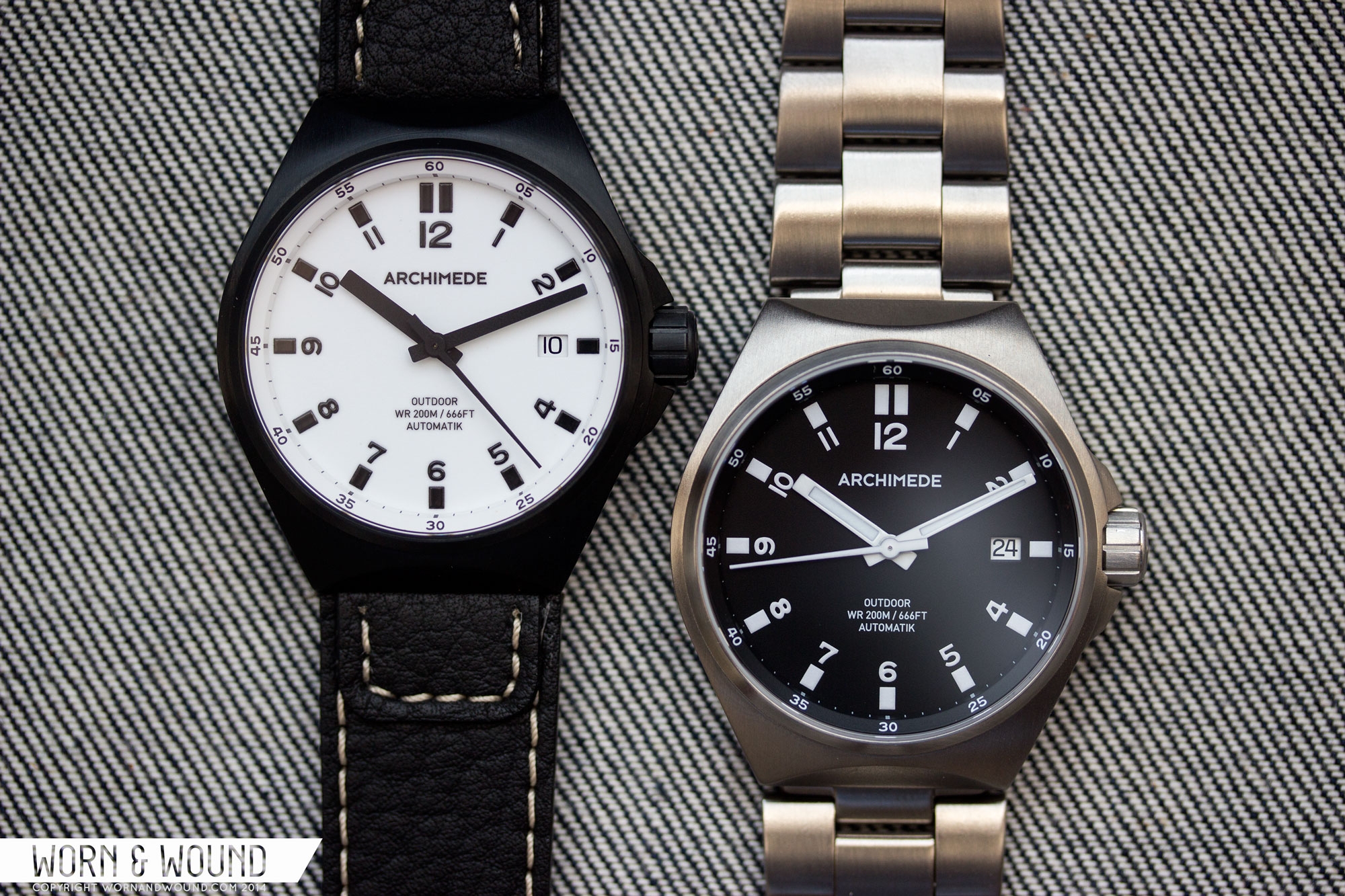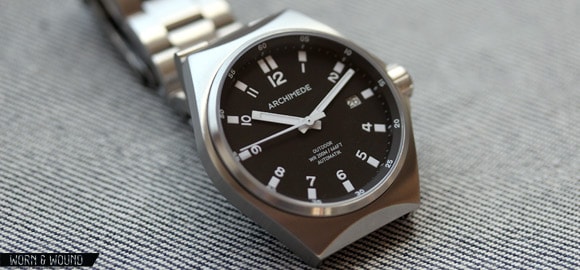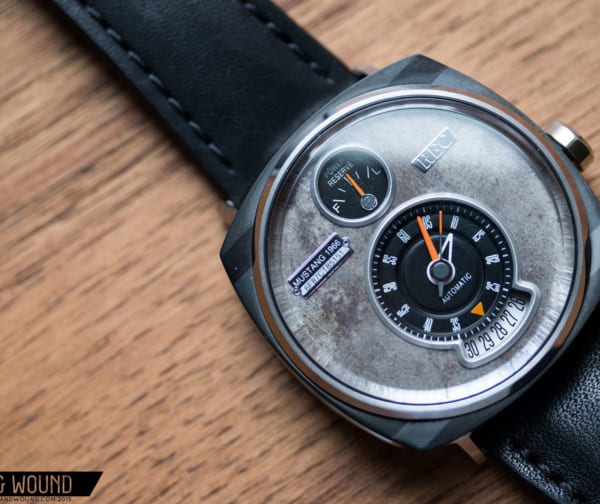A couple of years ago, we got the chance to review the Archimede Outdoor. We were impressed back then, but in the years that have past, have longed to revisit the watch. Not simply because we missed it, which we did, but because in those 2 years, we’ve seen so many watches that I kept thinking, “wow, the Outdoor was really unique… Perhaps more unique than we gave it credit for originally.” Which is true, there isn’t anything else quite like the Outdoor; it’s a daily watch, a tool watch, a field watch, a sport watch…all wrapped up into a compact, understated and well-priced package.
If that weren’t enough, they’ve also released two new versions of the watch, one of which replaced the version we originally reviewed. The new versions are the Protect, which features a hardened steel case (more on that later) and the PVD, which is simply PVD coated. They also had released a full-lume dial option at some point, which seemed worth examining. So, today we’re going to look at one of each, with a mix of options. Both feature sapphire crystals and are powered by the Sellita SW200 movement. The Protect and PVD as shown cost about $750 and $806 respectively.
Archimede Outdoor Protect
 Case: Hardened Stainless Steel
Case: Hardened Stainless Steel
Movement: SW200
Dial: Matte black
Lume: BGW9
Lens: Sapphire w/ AR
Strap: Hardened Steel Bracelet
Water Res.: 200m
Dimensions: 38.5 x 43.25mm
Thickness: 11.5 mm
Lug Width: 18 mm
Crown: 7 x 4 mm
Warranty: 2 years
Price: $750
Archimede Outdoor PVD
 Case: PVD Stainless Steel
Case: PVD Stainless Steel
Movement: SW200
Dial: Full Lume
Lume: BGW9
Lens: Sapphire w/ AR
Strap: Leather
Water Res.: 200m
Dimensions: 38.5 x 43.25mm
Thickness: 11.5 mm
Lug Width: 18 mm
Crown: 7 x 4 mm
Warranty: 2 years
Price: $806
Case
One of the more immediately striking features of the Outdoor is its unusual barrel case. I say unusual because, unlike most barrel-cased watches, this one feels very modern. Typically, a design like this would at least hint at 60’s and 70’s style. Instead, it feels like a very intentional design with practical goals in mind. Namely, the goals of being discreet and having a minimum of jagged edges that could potentially catch on to something. It’s also nice and compact at 38.5 x 43.25 x 11.5mm. Since nothing is really round, the diameter is a bit deceptive, but I’d still call this a small-medium watch.
Looking at it top down, the tapering of the barrel is dramatic, giving it a more aerodynamic and aggressive look than a vintage barrel. It’s also not a flat surface, though It might appear as such initially. From the side, one can see that it gently curves around, creating a more fluid shape. The hooded lug area is then scalloped away on the topside, creating a dramatic contour that looks like two semicircles pressing on the dial, bringing the eye towards the center. It’s clear, however, that these facets were meant to streamline the profile of the watch, removing an area that would potentially stick out. When you add in the slab sides and the blocky bezel, you have a really intriguing design that is much architectural as aesthetically pleasing.
On the right side is a large screw-down crown flanked by angular crown guards. The guards ramp up, out of the case to the crown. If you run your finger over them, they are completely smooth, furthering this “no-snag” design. Yet, they manage to be faceted in such a way as to be aggressive and stealth, especially on the PVD model. The crown is then 7 x 4mm with wide grooves and an Archimede “A” on the flat side. Proportionally, it’s large for the watch, but it looks right. The guards balance it out, and it adds to the underlying toughness of this small watch.
The two current models, the Protect and the PVD, visibly only differ in finish, but invisibly in hardness. The Protect has been hardened to 1200 vickers by diffusing carbon into the top layer of the watch, much like Sinn’s tegimenting (they don’t say if it’s the same or if it’s done by SUG, but it sounds similar). This makes it very scratch resistant and thus more durable and appropriate for sports/active use. This might end up the mantra of this article, but at under $1,000 for any of the Protect models, these are an outstanding value for a hardened case watch.
Visually, the Protect is brushed, but it looks a bit different than a classic brushing. This might be because of the treatment, but it’s like there is a fine blasting under the brushing, for a slightly more matte case. It’s simple and attractive. The PVD is a far more striking option, however. This case works very well in black, turning the unique geometry into something more fierce, with sharper angles and stealth lines.
Dial
The dial has not changed since we first reviewed the watch, though they did add the full-lume option, which we also have for review. Like the case, the dial is purpose driven, with at-a-glance legibility being paramount. In achieving this, they did something very clever with the chapter ring, which is another highlight of the watch, that I’ll discuss in a moment. However, unlike the case, the dial isn’t really sexy or stylized.
It’s blunt and informative, and while unique in the sense that it doesn’t seem to refer to anyone thing or another, might be a bit sterile. It’s honestly the only draw back of the watch, but one that I feel is overcome by its strengths. And, after wearing the watch for a while, it’s no-nonsense, function-driven approach becomes appealing in its own way. It’s the anti-fashion watch (that’s a bit extreme, but you know what I’m saying).
The dial surface is either matte black or matte white-lume depending on the option chosen. The markers are then either white-lume or black to contrast the surface below. The primary index consists of numerals in a fairly generic font, inside of a ring of blocks, all rotating with the angle of the hour. The only outliers are the markers and numeral at 12, which are larger and doubled. At 3, instead of a numeral is a date window. Otherwise, on the main dial there is just a fairly restrained “Archimede” logo below 12 and three lines of text reading “Outdoor, WR200m/666ft, Automatik” above 6. And that’s it for the main dial. Simple, clean and un-stylized.
Things get more interesting, or clever perhaps, as you move to the chapter ring. Rather than simply sitting on top of the dial surface, the chapter ring shoots straight up a millimeter or so and the chamfers up to the crystal. From above, you can see on the chamfered area small numerals for the minute/second, adding a quick and legible reference. The cool part is on the vertical wall of the ring, there is an index of marks for the individual minute or second. So, when you view the watch at any angle, which in reality you are always looking at a bit of an angle, the index is revealed. This is an interesting execution as it adds function while keeping the dial clean.
Finishing off the dial is a simple handset that, like the dial below, is pure function. The hours and minutes are both blocks, the minute longer and thinner than the hour with a slight taper. The seconds is a tapering stick. On the black dial, the hands are white with lume filling. On the white/lume dial, the hands are solid matte black.
Both dials feature BGW9 lume, which looks white and then glows a cool blue/green. Archimede seems to be able to achieve better lume than most of its German counter parts, with great saturation and a long lasting glow. On the black dial, the white hour numerals and markers glow, along with the hands. They are bright and easy to read. On the full-lume dial, it’s the dial surface that is glowing, showing everything else in silhouette. Once again, super legible and bright. That said, I’m not won over by full-lume dials yet. While I think the watch looks good with a white dial and black numerals, as the combo is stark and striking, the full-lume material is just a bit strange, always slightly glowing and blue tinted. That said, if you are buying this watch for its intended purpose, I could see how it might be the more functional option.
Straps
When buying the Outdoor, one has a few strap options: bracelet, leather or silicone. We got to try both the bracelet and leather, and, considering the pricing on these watches, I’d say go with with bracelet every time. On the protect model, the bracelet is also hardened(!) making the $750 price tag just amazing, and adds that extra layer of ruggedness. On the PVD model, the black bracelet just looks bad ass…enough said.
The bracelet design is also very nice. The watch features an 18mm lug width, which seems a touch narrow for the case. The bracelet makes up for this by having an 18mm endlink, which is folded, that hides under the case, and then the first link is actually 22mm wide, matching the edge of the case. It then tapers in to 18mm at the clasp. This continues the flow of the case into the bracelet for continuity. The bracelet itself is fairly thin, with a pleasant amount of space between links. This, plus the taper, give it a vintage look and feel, but for my money, it makes it much more comfortable than a stiff bracelet. The only negative for me is the clasp, which is very basic and not especially well-made.
The leather strap is nice too, just a bit less interesting/cost effective than the bracelet option. It’s a supple black leather with heavy graining and long, off-white edge stitching. It too is 22mm wide at the case, with an extra shoulder/loop that is 18mm, to fit in the lug. I like leather straps that do this, like the Di-Modell Chronissimo or RIOS Pilot, but I do wish this one tapered. I find tapering straps are pretty critical on barrel cases to create a smooth transition.
The Outdoors work on straps of other styles as well. I put the Protect on a whiskey RIOS Cordovan strap that added a dressier, more stylish edge to the watch. Though the gap between the case edge and the strap was a bit funny looking, the overall look was very appealing and warmer than the watch on the bracelet. Both options would be good for the office.
I then tried the PVD model on a black and grey “Bond” NATO, which also worked well. The lug spacing is tight, so this is one where you can’t slip the NATO through, but it does fit. The bi-tone coloring played well off of the PVD case and white dial, for a monochromatic palette. Ideally, the strap would have PVD hardware too, but you can get the gist. Naturally, this was a more casual, sporty option, but one that worked very nicely with the case shape.
On the Wrist
As one might expect from a watch this size, it wears very well. It’s small enough to sit nicely on top of the wrist, with a short lug-to-lug that ensures it wont over hang, but it has enough metal in the case to feel substantial. It also looks great. Despite the dial being a little bland, the package all together is rather handsome.
The case is sporty and smart, but reserved and the dial has nice contrast from the black and white combo. Though the case might have some aggressive lines, the dial is pretty neutral, so the aesthetic is also versatile. The Protect model in particular can be dressed up or down as needed. The PVD is sportier with a more tactical appeal, but I think that it’s overall so understated that one could wear it daily as well.
Conclusion
After not seeing this for about two years, the uniqueness of the case really speaks to me. I can’t think of another watch quite like it. It’s simple, elegant and nimble, yet is very sturdy and rugged. Exactly what a sport watch should be, nay a gentleman’s sport watch. The kind of watch that can be worn everyday wether at a desk or at the beach. Though Archimede is more known for their well-priced Flieger models, I think the Outdoor is really the hidden gem in their collection. It’s definitely their most original watch.
And… compared to other similar German watches, namely those by Sinn and Damasko, it’s probably the best value. They all offer a lot, each with their own pros and cons, but for $750 on a hardened bracelet, the Outdoor is simply the least expensive. The most comparable tegimented Sinn with a bracelet is the 856 non-utc, and that comes in at $1,990. Thinking about it more broadly, considering it’s German made, genuinely unique, and powered by a Sellita SW200, that price is fantastic compared to what’s out on the market in general. The only problem with the Outdoor Protect is cosmetic… it doesn’t say Protect anywhere on it, nor the case hardness, nor even that it’s made of hardened steel. So, it’s basically identical to the old version… the only way to tell is to try and scratch it, which is a terrible idea.
The PVD model is well priced too ($806 as tested), but since it’s more than the hardened version, it’s less compelling. That said, few PVD watches are as subtle and wearable. If I were to pick one up, I’d go for the black dial/PVD bracelet option. I’m sure that would have a certain Batman-esque charm to it. So, if you’re looking for a good everyday sport watch, I think the Archimede Outdoor is pretty hard to beat.









 Featured Videos
Featured Videos





















It’s well built, high-quality watch. But it’s almost….too simple?
I hate to sound so critical, but there’s something about this one that makes it look a lot like Nixon. Maybe it’s the massive crown and overly-basic hands. I’m not sure.
Agreed. I hate to be the guy that always gripes about pricing, but I guess that’s my mantle so I’ll just own it. $750-$800 for this watch just feels…absurd. Isn’t that exorbitant price tag at odds with the ethos of a watch intended to be an outdoorsy knockabout type?
I find the dial to be on the ugly side of bland. There’s a point when austerity and restraint go too far and cross into generic territory. I have a hard time with some PVD watches, too, as they can often appear to be plastic. The PVD/white dial just looks kind of cheap – like a non-designed $15 plastic Casio.
I like the idea of the hardening process used on the Protect model, but here it kind of feels like a reinforced bulletproof Camry. Sure, it would be a reliable tank, but it’s still bland, and who wants to pay six figures for a armored family sedan?
Actually, blandness would be like camoflage for an armoured car – it could blend into traffic and virtually dissappear.
Excellent review. Quick question: Which model is the Rios Cordovan strap shown above? Thanks!
Their Chicago strap is the only Cordovan one that looks like that, but they are sold out and weren’t offered in 18mm. Perhaps it is the Moscow?
Just curious, why are there rarely caseback pictures on W&W?
The case-back on this watch is fairly uninteresting, but I try to include them on every review.
Reminiscent of the original Zenith Defy from the late 1960’s, which had a faceted, octagonal barrel case, 300m water resistance, and a then novel shock absorption ring around the movement. Been wearing this one all summer!
thanks for sharing! that Zenith is wild!
A tool watch, below 40mm with hardened steel and at an affordable price. Domasko and Sinn take note.
Surface-hardened, like Sinn, but Damasko’s cases are hardened all the way through.
Ok worn and wound – here is the question – is this watch better than the sinn 556 – and if you had the choice which one would you own ?
Hey Zach,
Thanks for another gem review;) Your site is my reference if I’m itching to shop for another watch, always come here to check if you have reviewed it.
The Archimede OutDoor Protect review just made it easier to order it. Amazing pictures!!!